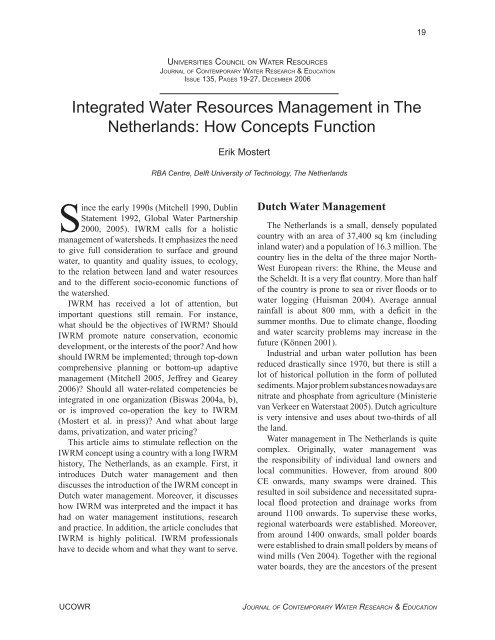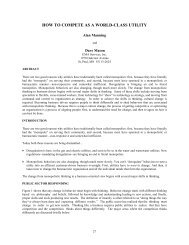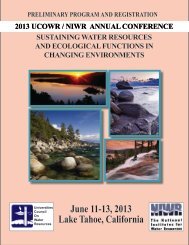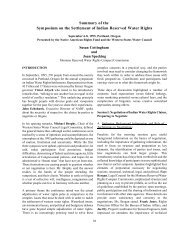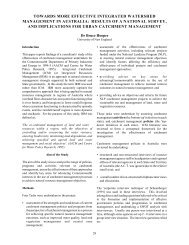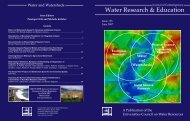18Cardwell. Cole, Cartwright, <strong>and</strong> Martinlevel. Since then she has worked with the US ArmyCorps <strong>of</strong> Engineers Institute for <strong>Water</strong> Resources whereshe became interested in the nation’s flooding problems<strong>and</strong> related policies. Currently she works with theNatural Resources Conservation Service in Columbia,Missouri as part <strong>of</strong> an interdisciplinary team developing<strong>and</strong> evaluating flood damage reduction projects forwatersheds in Missouri.LYNN A. MARTIN is an Environmental Planner at theU.S. Army Corps <strong>of</strong> Engineers, Institute for <strong>Water</strong> Resources.Past work includes range <strong>of</strong> Civil Works policy<strong>and</strong> environmental program implementation issues. Hercurrent work focuses on system approaches through watershedstudies, integrated water resources management,regional sediment management, <strong>and</strong> integrated coastalmanagement. Lynn has served on assignments to Corpsheadquarters, <strong>and</strong> the Office <strong>of</strong> the Assistant Secretary<strong>of</strong> the Army (Civil Works), developing Civil Works ecosystemrestoration policy <strong>and</strong> implementation guidance.Degrees: B.S. in Biology (Virginia Tech, Blacksburg,VA), M.S. in Environmental Planning (George MasonUniversity, Fairfax, VA).ReferencesGlobal <strong>Water</strong> Partnership. 2000. Integrated <strong>Water</strong>Resources Management Policy. TAC BackgroundPaper #4. Stockholm.Goodl<strong>and</strong>, R <strong>and</strong> H. Daly. 1996. Environmentalsustainability: Universal <strong>and</strong> non-negotiable.Ecological Applications 6:1002-1017.Inter-American Development Bank. 1998. Integrated<strong>Water</strong> Resources Management in Latin America <strong>and</strong>the Caribbean Technical Report No. ENV-123.Loucks, D. P. 2003. Managing America’s rivers:Who’s doing it? International <strong>Journal</strong> <strong>of</strong> RiverBasin Management 1(1):21-31.Muckleston K. W. 1990. Integrated watermanagement in the United States. In B. Mitchell.(Editor). Integrated <strong>Water</strong> Management:International experiences <strong>and</strong> perspectives.Belhaven Press, New York.President’s Council on Sustainable Development.1996. Sustainable America: A New Consensus.Government Printing Office, Washington, DC20402-9328. Online at http://Clinton2.nara.gov/PCSD/overview/.Stakhiv E. 1996. Perspectives on Corps watershedplanning. A briefing on 4 April 1996. Institute for<strong>Water</strong> Resources, Alex<strong>and</strong>ria, Virginia.United Nations Development Programme. 1990. Safe<strong>Water</strong> 2000. New York.U.S. Agency for International Development. 2003.Onlice at http://www.usaid.gov/environment/why_protect_water.html.U.S. Army Corps <strong>of</strong> Engineers. 1999. PolicyGuidance Letter 61, “Application <strong>of</strong> <strong>Water</strong>shedPerspective to Corps <strong>of</strong> Engineers Civil WorksPrograms <strong>and</strong> Activities”. CECW-AA, HQUSACE,Washington, DC 20314.U.S. Army Corps <strong>of</strong> Engineers. 2000. EngineeringRegulation (ER) 1105-2-100, “Guidance forConducting Civil Works Planning Studies (a.k.a.“Planning Guidance Notebook (PGN).” CEW-P,HQ-USACE, Washington, DC 20314.U.S. Army Corps <strong>of</strong> Engineers. 2002. EnvironmentalOperating Principles. USACE EnvironmentalOperating Principles <strong>and</strong> ImplementationGuidance. HQUSACE, Washington, DC 20314.U.S. Army Corps <strong>of</strong> Engineers. 2004. Civil WorksStrategic Plan Fiscal Year 2004 – Fiscal Year 2009.CECW-Z, HQUSACE, Washington, DC 20314.U.S. Department <strong>of</strong> Agriculture, U.S. Department <strong>of</strong>Commerce (National Oceanic <strong>and</strong> AtmosphericAdministration), U.S. Department <strong>of</strong> Defense, U.S.Department <strong>of</strong> Energy, U.S. Department <strong>of</strong> theInterior, U.S. Environmental Protection Agency,Tennessee Valley Authority <strong>and</strong> U.S. Army Corps<strong>of</strong> Engineers. 2000. Unifi ed Federal Policy for a<strong>Water</strong>shed Approach to Federal L<strong>and</strong> <strong>and</strong> ResourceManagement; Notice, Federal Register 65(202),October 18, pp. 62565-62572. Online at http://www.cleanwater.gov/ufp/UFP_final_FR.pdf.U.S. <strong>Water</strong> Resources Council. 1983. Economic<strong>and</strong> Environmental Principles <strong>and</strong> Guidelines for<strong>Water</strong> <strong>and</strong> Related L<strong>and</strong> Resources ImplementationStudies. U.S. Government Printing Office,Washington, DC.World Bank. 1993. Policy Paper : <strong>Water</strong> ResourcesManagement. Washington, D.C.World Bank. 2003a. Online at http://lnweb18.worldbank.org/ESSD/ardext.nsf/18ByDocName/<strong>Water</strong>ResourcesManagement.World Bank. 2003b. <strong>Water</strong> Resources Sector Strategy:Strategic Directions for World Bank Engagement.Washington D.C.World Commission on Environment <strong>and</strong> Development.1987. Our Common Future. Oxford UniversityPress, New York.UCOWRJOURNAL OF CONTEMPORARY WATER RESEARCH & EDUCATION
19UNIVERSITIES COUNCIL ON WATER RESOURCESJOURNAL OF CONTEMPORARY WATER RESEARCH & EDUCATIONISSUE 135, PAGES 19-27, DECEMBER 2006Integrated <strong>Water</strong> Resources Management in TheNetherl<strong>and</strong>s: How Concepts FunctionErik MostertRBA Centre, Delft University <strong>of</strong> Technology, The Netherl<strong>and</strong>sSince the early 1990s (Mitchell 1990, DublinStatement 1992, Global <strong>Water</strong> Partnership2000, 2005). IWRM calls for a holisticmanagement <strong>of</strong> watersheds. It emphasizes the needto give full consideration to surface <strong>and</strong> groundwater, to quantity <strong>and</strong> quality issues, to ecology,to the relation between l<strong>and</strong> <strong>and</strong> water resources<strong>and</strong> to the different socio-economic functions <strong>of</strong>the watershed.IWRM has received a lot <strong>of</strong> attention, butimportant questions still remain. For instance,what should be the objectives <strong>of</strong> IWRM? ShouldIWRM promote nature conservation, economicdevelopment, or the interests <strong>of</strong> the poor? And howshould IWRM be implemented; through top-downcomprehensive planning or bottom-up adaptivemanagement (Mitchell 2005, Jeffrey <strong>and</strong> Gearey2006)? Should all water-related competencies beintegrated in one organization (Biswas 2004a, b),or is improved co-operation the key to IWRM(Mostert et al. in press)? And what about largedams, privatization, <strong>and</strong> water pricing?This article aims to stimulate reflection on theIWRM concept using a country with a long IWRMhistory, The Netherl<strong>and</strong>s, as an example. First, itintroduces Dutch water management <strong>and</strong> thendiscusses the introduction <strong>of</strong> the IWRM concept inDutch water management. Moreover, it discusseshow IWRM was interpreted <strong>and</strong> the impact it hashad on water management institutions, research<strong>and</strong> practice. In addition, the article concludes thatIWRM is highly political. IWRM pr<strong>of</strong>essionalshave to decide whom <strong>and</strong> what they want to serve.Dutch <strong>Water</strong> ManagementThe Netherl<strong>and</strong>s is a small, densely populatedcountry with an area <strong>of</strong> 37,400 sq km (includinginl<strong>and</strong> water) <strong>and</strong> a population <strong>of</strong> 16.3 million. Thecountry lies in the delta <strong>of</strong> the three major North-West European rivers: the Rhine, the Meuse <strong>and</strong>the Scheldt. It is a very flat country. More than half<strong>of</strong> the country is prone to sea or river floods or towater logging (Huisman 2004). Average annualrainfall is about 800 mm, with a deficit in thesummer months. Due to climate change, flooding<strong>and</strong> water scarcity problems may increase in thefuture (Können 2001).Industrial <strong>and</strong> urban water pollution has beenreduced drastically since 1970, but there is still alot <strong>of</strong> historical pollution in the form <strong>of</strong> pollutedsediments. Major problem substances nowadays arenitrate <strong>and</strong> phosphate from agriculture (Ministerievan Verkeer en <strong>Water</strong>staat 2005). Dutch agricultureis very intensive <strong>and</strong> uses about two-thirds <strong>of</strong> allthe l<strong>and</strong>.<strong>Water</strong> management in The Netherl<strong>and</strong>s is quitecomplex. Originally, water management wasthe responsibility <strong>of</strong> individual l<strong>and</strong> owners <strong>and</strong>local communities. However, from around 800CE onwards, many swamps were drained. Thisresulted in soil subsidence <strong>and</strong> necessitated supralocalflood protection <strong>and</strong> drainage works fromaround 1100 onwards. To supervise these works,regional waterboards were established. Moreover,from around 1400 onwards, small polder boardswere established to drain small polders by means <strong>of</strong>wind mills (Ven 2004). Together with the regionalwater boards, they are the ancestors <strong>of</strong> the presentUCOWRJOURNAL OF CONTEMPORARY WATER RESEARCH & EDUCATION
- Page 3: Journal of ContemporaryWater Resear
- Page 6 and 7: 2Bruce Hooperinstitutional, and tem
- Page 11 and 12: IWRM: Governance, Best Practice, an
- Page 13 and 14: IWRM: Defi nitions and Conceptual M
- Page 15 and 16: IWRM: Defi nitions and Conceptual M
- Page 17 and 18: IWRM: Defi nitions and Conceptual M
- Page 19: IWRM: Defi nitions and Conceptual M
- Page 24 and 25: 20Mostert26 water boards responsibl
- Page 26 and 27: 22MostertTable 1. Third National Wa
- Page 28 and 29: 24MostertImplementationThe ambitiou
- Page 30 and 31: 26MostertBiswas, A. K. 2004b. Respo
- Page 32 and 33: 28UNIVERSITIES COUNCIL ON WATER RES
- Page 34 and 35: 30Ashton, Turton, and Rouxresource
- Page 36 and 37: 32Ashton, Turton, and Rouxassumptio
- Page 38 and 39: 34Ashton, Turton, and RouxEffective
- Page 40 and 41: 36UNIVERSITIES COUNCIL ON WATER RES
- Page 42 and 43: 38Hussey and Doversin water policy
- Page 44 and 45: 40Hussey and Dovers1994 Council of
- Page 46 and 47: 42Hussey and Doversestablished Thes
- Page 48 and 49: 44Hussey and DoversTable 1. Typolog
- Page 50 and 51: 46Hussey and Doversassessment appro
- Page 52 and 53: 48Hussey and Doverspolicy goals.Bey
- Page 54 and 55: 50Hussey and DoversFrawley, K. 1994
- Page 56 and 57: 52Mitchelloften took three to four
- Page 58 and 59: 54Mitchelltree preservation plans;
- Page 60 and 61: 56UNIVERSITIES COUNCIL ON WATER RES
- Page 62 and 63: 58Genskow and Borna series of chall
- Page 64 and 65: 60Genskow and BornTable 1. Watershe
- Page 66 and 67: 62Genskow and Bornthe first Dungene
- Page 68 and 69: 64Genskow and BornWashington, DC.Ko
- Page 70 and 71: 66Green and Fernández-BilbaoWithin
- Page 72 and 73:
68Green and Fernández-Bilbaosubjec
- Page 74 and 75:
70Green and Fernández-Bilbaoinflue
- Page 76 and 77:
72Green and Fernández-BilbaoBerbel
- Page 78 and 79:
74UNIVERSITIES COUNCIL ON WATER RES
- Page 80 and 81:
76BallweberEstablish AdvisoryCommit
- Page 82 and 83:
78Ballweberattributes in others (Ch
- Page 84 and 85:
80UNIVERSITIES COUNCIL ON WATER RES
- Page 86 and 87:
82Barreiraand ground water. To this
- Page 88 and 89:
84Barreirawith other states for int
- Page 90 and 91:
86UNIVERSITIES COUNCIL ON WATER RES
- Page 92 and 93:
88Davis and ThrelfallResource Manag
- Page 94 and 95:
90Davis and ThrelfallTable 2. Thirt
- Page 96 and 97:
92Davis and Threlfallby regional an
- Page 98 and 99:
94Davis and Threlfallenforcement, a
- Page 100 and 101:
96Davis and Threlfallhusbandry prac
- Page 102 and 103:
98Davis and ThrelfallNew Zealand: T
- Page 104 and 105:
100UNIVERSITIES COUNCIL ON WATER RE
- Page 106 and 107:
102Lamoree and van SteenbergenIt is
- Page 108 and 109:
104Lamoree and van Steenbergenand n
- Page 110 and 111:
106Lamoree and van Steenbergeninter
- Page 112 and 113:
108BourgetWorks Planner Capability
- Page 114 and 115:
110Bourgetwith over 600 people resp
- Page 116 and 117:
112Bourgetgovernment’s intrusion
- Page 118 and 119:
114Bourget4.management, drought man
- Page 120 and 121:
116McKayFigure 1. The four paradigm
- Page 122 and 123:
118McKay4. Paradigm 4 (which commen
- Page 124 and 125:
120McKaythree main functions:1. ass
- Page 126 and 127:
122McKayState Implementation of the
- Page 128 and 129:
124McKayTable 2. Corporate governan
- Page 130 and 131:
126McKayFigure 4. Qu. 26 - The ESD
- Page 132 and 133:
128McKayFigure 7. Qu.93- This organ
- Page 134 and 135:
130McKayBrundtland Report. 1987. Ou
- Page 136 and 137:
132UCOWR BOARD OF DIRECTORS/COMMITT
- Page 138 and 139:
134BENEFITS OF UCOWR MEMBERSHIPThe
- Page 140 and 141:
136Past Issues of the Journal of Co
- Page 142 and 143:
138Academic Organizations Membershi
- Page 144 and 145:
140Individual Membership Applicatio
- Page 146 and 147:
Universities Council on Water Resou
- Page 148:
Integrated Water Resources Manageme


